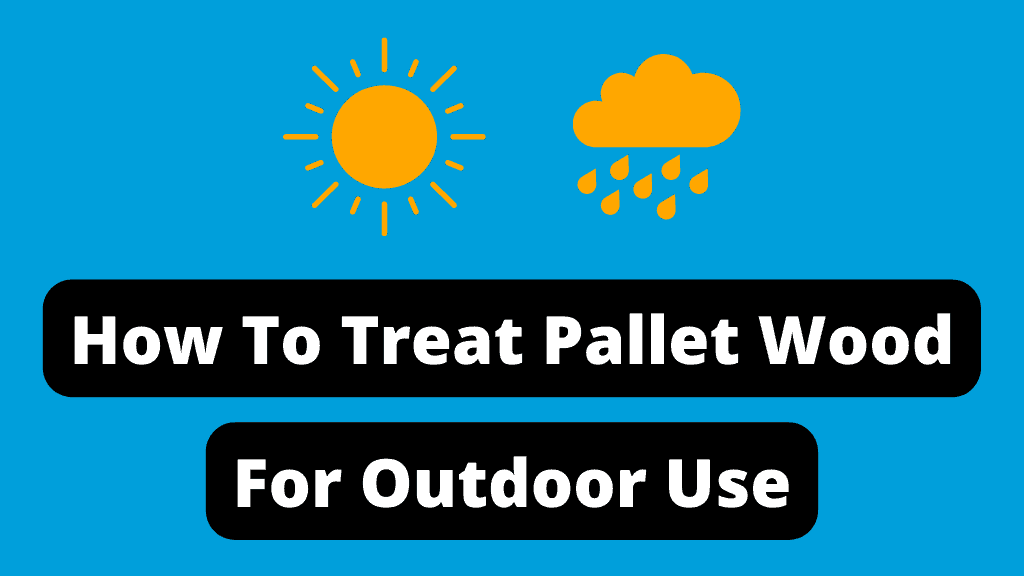Pallet wood is an economical source of material for do-it-yourselfers and professionals alike, but it sometimes needs a little TLC before use. Here we’ll show you how to treat pallet wood for outdoor use so you can enjoy your finished projects for years to come.
Wood pallets are a handy resource for every DIYer – you can build projects, planter boxes, furniture, and more. But how do you treat the wood?
There are several ways to treat pallet wood for outdoor use. These include a penetrating oil finish, a film finish, and a solid epoxy finish. Many products are available to help with this!
To learn more about how to treat pallet wood for outdoor use, continue reading below!
Why is Pallet Wood So Popular?
As a woodworking enthusiast, you’ve probably heard of pallet wood. But before you decide to use it for your next project, you should know why so many people love using it:
1) It’s cheap and readily available – Pallets are an abundant source of cheap wood that can be used for many projects. Homeowners and DIYers can use pallet wood for everything from home decor to furniture.
2) Pallet wood is easy to cut – It doesn’t require any special tools or knowledge in order to work with pallet boards; just grab a saw and start cutting!
3) Reused material – Since the wood is being used again, pallets are a great way to recycle material that would otherwise end up in landfills or waste piles.
4) Made of a renewable resource – Wood pallets are made from trees, which are renewable resources. That means your project will not only be functional but also environmentally friendly!
5) You can make it look however you want – Wood stains, paint, and even finishing with a clear coat of polyurethane will allow for endless design possibilities.
So, what are you waiting for? Get started on your pallet project today!
Why treat pallet wood for outdoor use?
If you don’t treat your pallet wood before using it outdoors, it won’t last long. The elements will strip away its color and decay the wood, leaving behind an ugly mess. But if you treat the wood with the proper finish, you can make your project look better while making sure it withstands the elements for a long time.
If you want to make the most out of your pallets, then you’ll want to stain them before you put them to work. This gives you the ability to create a cohesive look that ties everything together.
If you’re looking for a way to save money, treating pallet wood is one of the easiest ways to do so. By treating the wood with a sealant or stain, you’ll be able to get more use out of your materials without having to spend extra money on new ones. This is especially helpful when you’re working on a tight budget.
Always read the manufacturer’s directions for any specific steps or drying times between coats of your particular finish product.
I wrote another article about pallets and wood rot.
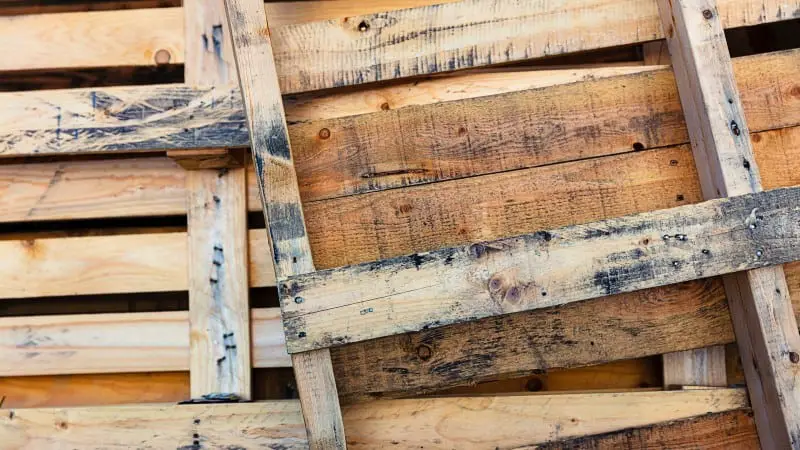
You can use an oil finish
A good option is to use an oil finish on your pallet. These finishes penetrate deep into the wood fibers and create a barrier that resists moisture – which makes it more durable when exposed to outdoor elements like rain or snow. You’ll want to use tung oil, linseed oil, hemp oil, or something similar.
Tung oil
Tung oil is a natural finish that’s also known as China wood oil. It offers great water resistance and can be used for projects both inside and outside.
One Tung oil product that can be used outdoors is Sutherland Welles Exterior Polymerized Tung oil sealer. It protects against the harsh ultraviolet light found in an outdoor environment and includes a fungicide to combat mold, mildew, and fungi.
Another product is Outdoor defense oil, made by The Real Milk Paint Company. This mixture of tung oil, pine oil, and zinc provides some protection against mold, mildew as well as UV radiation – so it’s good to use for outdoor furniture and similar DIY projects!
Tung oil is a great product for treating pallet wood for outdoor use. It can be applied to the wood through a variety of methods, and it will help to repel water. This link leads to more information about Tung oil.
Linseed oil
Linseed oil is a natural oil that is extracted from the seeds of flax plants. It can be used as a wood finish on wood because it dries to form a protective coat. It can be used both indoors and outdoors.
Applying linseed oil is a simple process. You can use a brush or rag to apply it, so it’s ideal for DIYers who aren’t familiar with finishing techniques. This link leads to more information about Linseed oil.
Hemp oil
Hemp oil is a natural sealer and preservative. This means that it will help protect your wood from weathering, or damage due to water.
Hemp oil is a great finish for wood because it’s completely non-toxic. It’s also easy to apply and use, so it’s a great option if you’re new to woodworking or just want an easy way to protect your pallet wood. This link shows an example of hemp oil that is suitable for outdoor use.
It’s important to note that rags soaked in oil-based finishing products (such as paints, stains, and varnishes) can combust spontaneously, causing a fire. To avoid this, let the rags dry out before disposing of them in a metal container. The container should have a cap and be filled with water mixed with a detergent, which will break down the oil. For more information, see this safety notice.
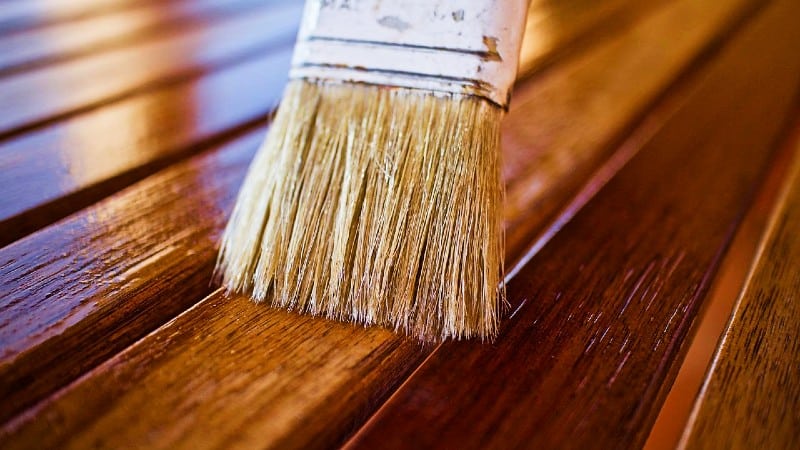
You can use paint
If you’re a DIYer or someone who’s just getting started in woodworking, you might be wondering about painting your pallets. It’s not as simple as just slapping on some paint. In fact, there are a few things to keep in mind when it comes to making sure your project can stand up to the elements. First and foremost, think about moisture resistance. If your pallet wood is going to be outside, it will be exposed to rain, snow, and other forms of precipitation.
Second of all, consider UV protection because exposure to sunlight – even indirect sunlight – can cause fading in certain kinds of wood finishes. Harsh sunlight can even cause cracks in the wood!
Is there a way to take care of these problems?
Yes! – You can give pallet wood a smooth, finished look by applying chalk paint and then adding two coats of lacquer for protection (this link shows how that works).
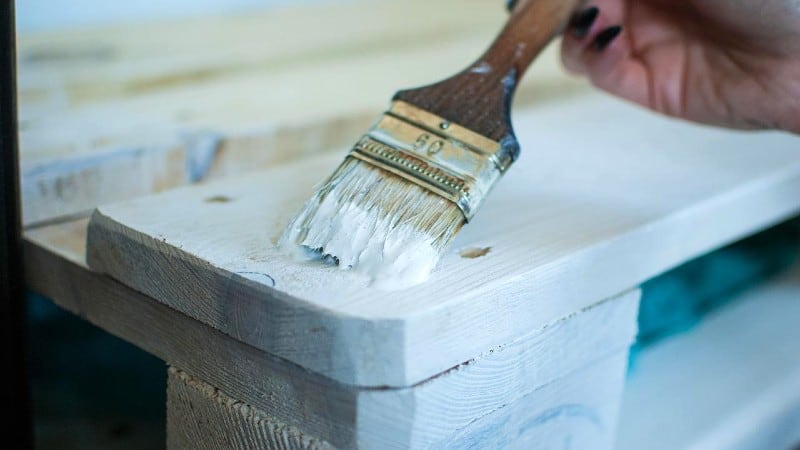
You can use marine spar varnish
Marine spar varnish is made to withstand water, UV radiation, and chemicals. It provides excellent protection from moisture – rain or snow stays on the surface rather than soaking in.
Let’s discuss where the term “spar varnish” originated. A spar is a wooden pole that holds the sail of a ship, so this type of finish was used on areas likely to be exposed to water and sunlight.
This makes it ideal for outdoor pallet wood projects like fences, planters, furniture, or even patio decks. It’s also great for indoor projects like cabinets and shelves because it resists stains from condensation or spills.
Marine spar varnish is typically used on boats and other structures that are exposed to the elements. It’s made from a combination of chemicals, resins, and solvents that are blended together to create a coating that’s tough and durable.
If you’re looking for a way to protect your pallet wood from water and sun, marine spar varnish is the way to go. It’s easy to apply, works well at protecting against moisture, and makes the wood look nice as well!
However, it can be a little pricey and you may have to apply several coats to protect your pallet wood.
Nevertheless, this can be a good choice if you want your pallets to last longer outdoors.

You can use an epoxy finish
If you’re looking for a solid finish that provides good resistance to water, an epoxy finish might be the way to go.
The epoxy finish is made of two parts: resin and hardener. Mix these in a separate container before pouring onto your pallet wood; you can pour directly on or use a squeegee, card, foam brush, etc. to spread the mixture evenly across its surface. You can also use a bristle brush to get into corners and crevices.
Epoxy, by itself, provides very little protection from the harmful effects of ultraviolet radiation – so you’ll need to add a finish such as marine varnish in order to provide additional protection. This might require several coats of varnish. This link describes a process for applying epoxy to outdoor wood.
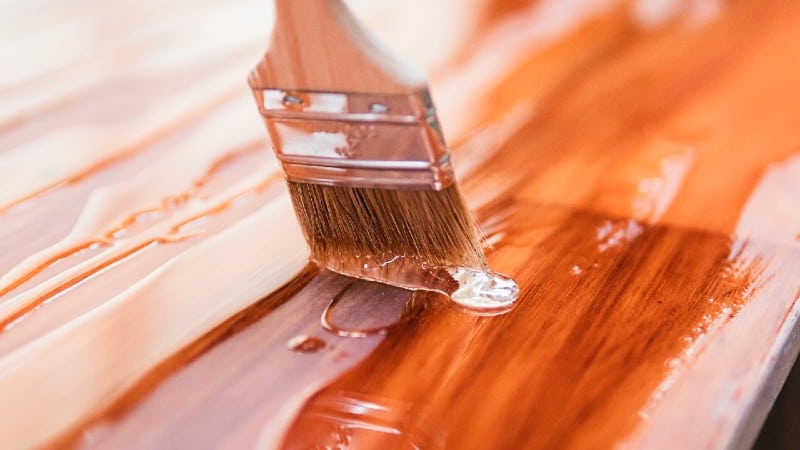
Should you use pallet wood outdoors?
The earlier sections mentioned how to treat pallets with wood finish in order to protect them from the outdoors. This leads to another question: Should you even use pallet wood outdoors?
You certainly can find a finish that will protect them, but not all situations are the same. All of these things – sunlight, standing water, environmental impact, and use in an outdoor garden – can affect the durability (or lack thereof) of your finished project. They also influence how you should treat pallet wood to ensure it will hold up well. These factors are covered below:
1) Direct exposure to sunlight – Sunlight and UV rays can cause wood to fade and degrade, so make sure anything that is going outside is protected from direct sunlight. With multiple coats, marine spar varnish offers protection against UV radiation.
2) Standing water – Standing water will cause wood rot and damage. An epoxy finish coated with varnish will offer very good protection against water.
3) Environmental impact – There are many different ways to finish your pallet project–and some finishes are better for the environment than others. For example, some oil finishes, such as tung oil, linseed oil, or hemp oil can be entirely natural. They can even be safe for food contact, small children, and pets. However, these oils are often mixed with other chemicals such as solvents and drying agents when used in finishing products. Some of these products can be toxic and bad for the environment. I wrote another article about burning pallet wood.
4) Use in an outdoor garden – Wood can be treated with natural oils to protect it from the elements, but finishes with toxic additives should not be used since they can leech into the soil and get taken up by plants. This is especially important when considering that some plants are intended as food – you don’t want to ingest these chemicals!
An alternative would be to use an environmentally friendly finish on the pallet wood. This link leads to several choices of finishes.
Another option is to use a wood that resists water, such as cedar or redwood. In the United States, most pallets are made of pine and oak—so you probably wouldn’t be able to use pallet wood in this situation.
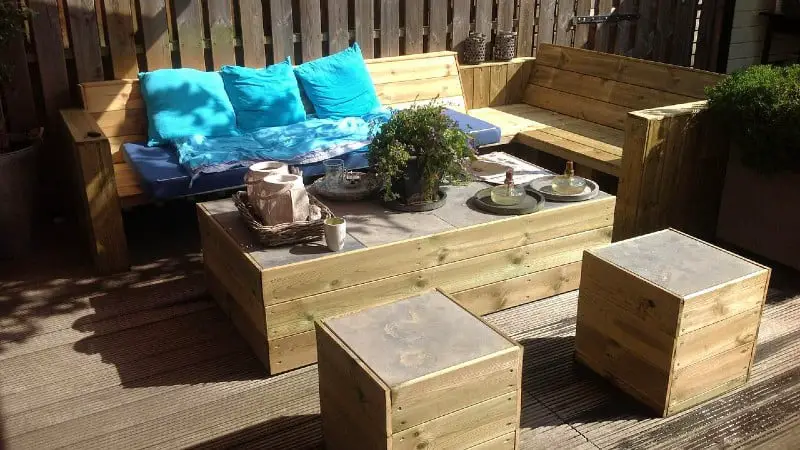
There are many ways to prepare pallet wood for outdoor use.
There are many ways to prepare pallet wood for outdoor use. The best one for you depends on the project, your budget, and your experience level.
If you’re a beginner at woodworking, you can use an oil finish. These products penetrate deep into the wood and provide good protection against moisture.
If you want to try your hand at finishing, linseed oil, hemp oil, and tung oil are all good choices.
If you are looking for more information, I wrote another article about pallet cleaning.

Final words: How To Treat Pallet Wood For Outdoor Use
So, there you have it! If you’re looking to add something different to your outdoor space, pallet wood is the perfect material. It’s free or inexpensive, it’s easy to work with, and can last for years if treated properly. How can you finish pallet wood?
– You can use an oil finish: tung oil, linseed oil, or hemp oil, along with others.
– You can use paint
– You can use marine spar varnish
– You can use an epoxy finish
– You can use other finishing products
Each of these methods has its own advantages and disadvantages – you’ll want to make sure that whichever one you choose is compatible with the type of project you’re working on and that it will last long enough for your needs.
Additionally, keep in mind that some finishes may not be suitable for outdoor use or may require additional care when used outdoors.
Now that you know how to treat pallet wood for use outdoors, try it yourself!
Did you enjoy reading this article? If so, you might like to visit my Pinterest profile. It contains pins about Woodworking, Tools, DIY & Crafts, Pallets, and more!

